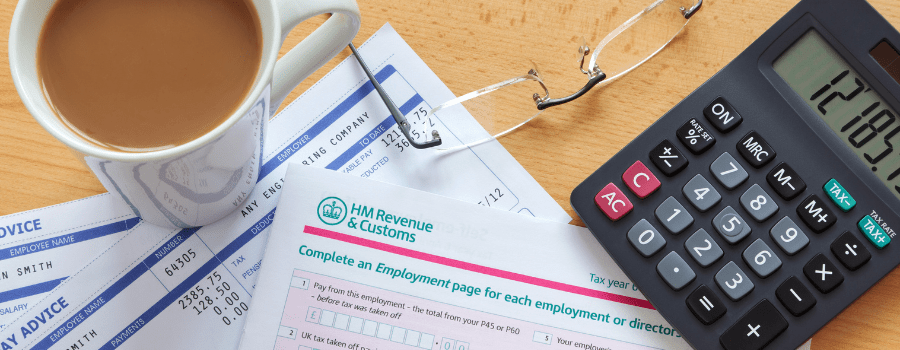Tax Rates & Thresholds – Changes for the 2022/23 Tax Year
April 6th 2022 is the start of the 2022/2023 tax year and as with all new tax years, comes with a multitude of changes that impact employers and employees alike.
When operating your payroll as an employer, these new rates must be utilised to ensure you pay staff the correct amount and provide accurate information to HMRC.
To help you prepare for the new tax year, our latest blog post explains the current rates of tax free personal allowances, income tax rates and bands, national insurance contributions and the national minimum and living wages.
Tax Free Personal Allowance
The personal allowance is the amount of income employees can earn before they pay income tax. The tax they pay beyond this is dependent on their tax band which is determined by their overall income.
In 2021, the personal allowance was increased in line with inflation to £12,570. However, the allowance for the 2022/2023 tax year will remain at £12,570 for workers earning less than £100,000. This means that employees can receive up to £1,048 per month before paying any income tax on their earnings.
If you earn more than £100,000, your personal allowance gradually reduces based on your income.
Income Tax Rates and Bands
After the £12,570 personal allowance, income tax is deducted at a rate determined by the amount of taxable income received, the rates for the 2022/2023 tax year remain unchanged:
| Tax Band | Taxable Income | Rate of Income Tax |
| Personal Allowance | Up to £12,570 | 0% |
| Basic | £12,571 to £50,270 | 20% |
| Higher | £50,271 to £150,000 | 40% |
| Additional | £150,000+ | 45% |
National Insurance Thresholds
National Insurance Contributions (NICs) are deducted from the pay of employees earning over the lower earnings limit. For the 2022/2023 tax year, the lower earnings limit is £6,396 per year.
An employee will pay NICs on any earnings between the primary threshold and the upper earnings limit. From 6th July 2022, the primary threshold will be increasing from £9,880 to £12,570 per year.
In April 2022, the rate of NICs paid by employees and employers increased by 1.25% for the Health and Social Care Levy. From 6th April 2023, this becomes a separate new tax of 1.25% which applies to the following classes of NIC:
- Employers – Class 1A and Class 1B
- Employees – Class 1 (above primary and secondary thresholds)
- Self Employed – Class 4
With both these changes considered, employees earning less than approximately £34,000 per year will benefit as they will pay less NI overall than what they did last year.
Employees earning more than £34,000 will pay more NI than they did in the last year in most cases.
Employee Contribution Rates
Class 1 national insurance is deducted through PAYE from the employees’ pay, the current rates of NICs are:
| National Insurance Category | Earnings above the primary threshold (currently £9,880 rising to £12,570 in July 2022) | Earnings above the primary threshold up to the upper earnings limit (currently £50,270) | Earnings above the upper earnings limit |
| A | 13.25% | 13.25% | 3.25% |
| B | 7.1% | 7.1% | 3.25% |
| C | 0% | 0% | 0% |
| H (Apprentice under 25) | 0% | 13.25% | 3.25% |
| M (Under 21) | 0% | 13.25% | 3.25% |
Employer Contribution Rates
Additionally, employers pay national insurance to HMRC as part of their PAYE bill, the current rates of employer NICs are:
| National Insurance Category | Earnings above the secondary threshold (£9,100 per year) | Earnings above the primary threshold up to the upper earnings limit (currently £50,270) | Earnings above the upper earnings limit |
| A | 15.05% | 15.05% | 15.05% |
| B | 15.05% | 15.05% | 15.05% |
| C | 15.05% | 15.05% | 15.05% |
| H (Apprentice under 25) | 0% | 0% | 15.05% |
| M (Under 21) | 0% | 0% | 15.05% |
There are different classes and rates for less common types of employment, further information can be found on the GOV.UK website.
National Minimum Wage & National Living Wage
The National Minimum Wage (NMW) is the rate of pay per hour that all workers are entitled to by law, it is a criminal offence not to pay someone at least the NMW.
The National Living Wage (NLW) is the minimum rate of pay per hour for workers that are aged 23 and over, there are some exceptions to this such as when the employee is in the first year of their apprenticeship.
From April 2022, the rates are of minimum pay are:
| Category | Rate of Pay (hourly) |
| Aged 23+ (NLW) | £9.50 |
| Aged 21-22 | £9.18 |
| Aged 18-20 | £6.83 |
| Aged under 18 | £4.81 |
| Apprentices aged under 19 or in their first year of apprenticeship | £4.81 |
When Does the 2022/2023 Tax Year Start and End?
The 2022/2023 tax year will start on the 6th April 2022 and end on the 5th April 2023.
Stay On Top of Your Tax Obligations with Equifino
We hope this blog post has helped you understand your tax obligations for the 2022/2023 tax year.
Tax can be confusing for employers and with changes happening every year, staying on top of your responsibilities without specialist accounting software or help from an expert can be challenging.
At Equifino, we help businesses simplify their tax with a range of accounting services including tax advice & planning. To find out more, call us on 0117 203 4010 or fill out a contact form and we will get back to you.




